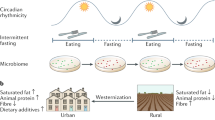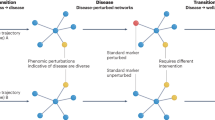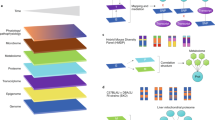Abstract
The success of the Human Genome Project and the spectacular development of broad genomics tools have catalyzed a new era in both medicine and nutrition. The terms pharmacogenomics and nutrigenomics are relatively new. Both have grown out of their genetic forbears as large-scale genomics technologies have been developed in the last decade. The aim of both disciplines is to individualize or personalize medicine and food and nutrition, and ultimately health, by tailoring the drug or the food to the individual genotype. This review article provides an overview of synergies and differences between these two potentially powerful science areas. Individual genetic variation is the common factor on which both pharmacogenomics and nutrigenomics are based. Each human is genetically (including epigenetics) unique and phenotypically distinct. One of the expectations of both technologies is that a wide range of gene variants and related single-nucleotide polymorphism will be identified as to their importance in health status, validated and incorporated into genotype based strategies for the optimization of health and the prevention of disease. Pharmacogenomics requires rigorous genomic testing that will be regulated and analyzed by professionals and acted on by medical practitioners. As further information is obtained on the importance of the interaction of food and the human genotype in disease prevention and health, pharmacogenomics can provide an opportunity driver for nutrigenomics. As we move from disease treatment to disease prevention, the two disciplines will become more closely aligned.
This is a preview of subscription content, access via your institution
Access options
Subscribe to this journal
Receive 12 print issues and online access
$259.00 per year
only $21.58 per issue
Buy this article
- Purchase on Springer Link
- Instant access to full article PDF
Prices may be subject to local taxes which are calculated during checkout
Similar content being viewed by others
References
Andreassi MG, Botto N, Cocci F, Battaglia D, Antonioli E, Masettiet S et al. (2003). Methylenetetrahydrofolate reductase gene C677T polymorphism, homocysteine, vitamin B12, and DNA damage in coronary artery disease. Hum Genet 112, 171–177.
Bamshad M, Wooding S, Salisbury BA, Claibourne SJ (2004). Deconstructing the relationship between genetics and race. Nat Rev Genet 5, 598–609.
Baudin B (2000). Angiotensin I-converting enzyme gene polymorphism and drug response. Clin Chem Lab Med 38, 853–856.
Bergmann MM, Bodzioch M, Bonet ML, Defoort C, Lietz G, Mathers JC (2006). Bioethics in human nutrigenomics research: European Nutrigenomics Organisation workshop report. Br J Nutr 95, 1024–1027.
Bild AH, Yao G, Chang JT, Wang Q, Potti A, Chasse D et al. (2006). Oncogenic pathway signatures in human cancers as a guide to targeted therapies. Nature 439, 353–357.
Blum K, Chen TJH, Blum SH, Downs BW, Braverman ER, Mengucci JE et al. (2006). Nutrigenomics and pharmacogenomics: a scientific wonderland. Soc Sci Inform 45, 35–52.
Bowden S, Bardenhagen F, Ambrose M, Whelan G (1994). Alcohol, thiamin deficiency, and neuropsychological disorders. Alcohol Alcohol Suppl 2, 267–272.
Camilo ME, Paiva SA, O'Brien ME, Booth SL, Davidson KW, Sokoll LJ et al. (1998). The interaction between vitamin K nutriture and warfarin administration in patients with bacterial overgrowth due to atrophic gastritis. J Nutr Health Aging 2, 73–78.
Chakravarty A (2001). Single nucleotide polymorphisms: to a future of genetic medicine. Nature 409, 822–823.
Chen JC, Huang KC, Wingerd B, Wu WT, Lin WW (2004). HMG-CoA reductase inhibitors induce COX-2 gene expression in murine macrophages: role of MAPK cascades and promoter elements for CREB and C/EBPâ. Exp Cell Res 301, 305–319.
Chen YT (2001). Glycogen storage diseases and other inherited disorders of carbohydrate metabolism. In: Braunwald E, Fausi AS, Kasper DL, Hauser SL, Longo DL, Jameson JL (eds). Harrison's Principles of Internal Medicines. McGraw-Hill: New York. pp 2288–2289.
Child B (1988). Genetic variation and nutrition. Am J Clin Nutr 48, 1500–1504.
Chin YW, Balunas MJ, Chai HB, Kinghorn AD (2006). Drug discovery from natural sources. AAPS J 8, E239–E253.
Corthesy-Theulaz I, den Dunnen JT, Ferre P, Geurts JM, Muller M, van Belzen N et al. (2005). Nutrigenomics: the impact of biomics technology on nutrition research. Ann Nutr Metab 49, 355–365.
Daniel SB, Daniel AP, Kelly NW, Aaron BM, Thomas JS, Joseph LA (2006). National surveillance of emergency department visits for outpatient adverse drug events. JAMA 296, 1858–1866.
Defeat Diabetes Association (2003). Food portions may explain the ‘French Paradox’ of rich foods and a thin population. (posted 28/08/03),http://www.defeatdiabetes.org/Articles/diet030828.htm.
Della Penna D (1999). Nutritional genomics: manipulating plant micronutrients to improve human health. Science 285, 375–379.
Dennis C (2003). Epigenetics and disease: altered states. Nature 421, 686–688.
Dormann H, Neubert A, Criegee-Rieck M, Egger T, Radespiel-Troger M, Azaz-Livshits T et al. (2004). Readmissions and adverse drug reactions in internal medicine: the economic impact. J Int Med 255, 653–663.
Duster T (2005). Race and reification in science. Science 307, 1050–1051.
Editorial (2001). Defining a new bioethic. Nat Genet 28, 297–298.
Eichelbaum M, Ingelman-Sundberg M, Evans WE (2006). Pharmacogenomics and individualised drug therapy. Annu Rev Med 57, 119–137.
Elliott R, Ong TJ (2002). Nutritional genomics. BMJ 324, 1438–1442.
Endres S, Ghorbani R, Kelley VE, Georgilis K, Lonnemann G, van der Meer JW et al. (1989). The effect of dietary supplementation with n-3 polyunsaturated fatty acids on the synthesis of interleukin-1 and tumor necrosis factor by mononuclear cells. New Engl J Med 320, 265–271.
Evans WE, Hon YY, Bomgaars L, Coutre S, Holdsworth M, Janco R et al. (2001). Preponderance of thiopurine-S-methyltransferase deficiency and heterozygosity among patients intolerent to mercaptopurine or azathioprine. J Clin Oncol 19, 2293–2301.
Evans WE, Relling MV (2004). Moving towards individualized medicine with pharmacogenomics. Nature 429, 464–468.
Feinberg AP (2001). Cancer epigenetics takes center stage. Proc Natl Acad Sci USA 98, 392–394.
Ferguson LR (2006). Nutrigenomics: integrating genomic approaches into nutrition research. Mol Diagn Ther 10, 101–108.
Feuk L, Carson AR, Scherer SW (2006). Structural variation in the human genome. Nat Rev Genet 7, 85–97.
FitzGerald RJ, Murray BA, Walsh DJ (2004). Hypotensive peptides from milk proteins. J Nutr 134, 980S–988S.
Floersheim GL, Bianchi L, Probst A, Chiodetti N, Honegger CG (1984). Influence of zinc, D-penicillamine and oxygen on poisoning with Amanita phalloides. Zinc accelerates liver regeneration and prevents the depletion of brain noradrenaline caused by the mushroom. Agents Actions 14, 24–30.
Gabriel SB, Schaffner SF, Nguyen H, Moore JM (2002). The structure of haplotype blocks in the human genome. Science 296, 2225–2229.
Gail PAK (2005). Emerging concepts in nutrigenomics: a preview of what is to come. Nutr Clin Practice 20, 75–87.
GeneWatch (UK) (2006). Your diet tailored to your genes: preventing diseases or misleading marketing?. http://www.genewatch.org/uploads/f03c6d66a9b354535738483c1c3d49e4/Nutrigenomics.pdf.
German JB, Roberts MA, Watkins SM (2003). Genomics and metabolomics as markers for the interaction of diet and health: lessons from lipids. J Nutr 133, 2078S–2083S.
Gillies PJ (2003). Nutrigenomics: the rubicon of molecular nutrition. J Am Diet Assoc 103, S50–S55.
Goldberg AC, Ostlund Jr RE, Bateman JH, Schimmoeller L, McPherson TB, Spilburg CA (2006). Effect of plant stanol tablets on low-density lipoprotein cholesterol lowering in patients on statin drugs. Amer J Cardiol 97, 376–379.
Grimble RF (2002). Inflammatory status, insulin resistance. Curr Opin Clin Nutr Metab Care 5, 551–559.
Grimble RF, Howell WM, O'Reilly G, Turner SJ, Markovic O, Hirrell S et al. (2002). The ability of fish oil to suppress tumor necrosis factor-alpha production by peripheral blood mononuclear cells in healthy men is associated with polymorphisms in genes which influence TNF-alpha production. Am J Clin Nutr 76, 454–459.
Guo Y, Shafer S, Weller P, Usuka J, Peltz G (2005). Pharmacogenomics and drug development. Pharmacogenomics 6, 857–864.
Guttmacher AE, Collins FS (2002). Genomic medicine: a primer. N Engl J Med 347, 1512–1520.
Guttmacher AE, Collins FS (2003). Welcome to the genomic era. N Engl J Med 349, 996–998.
Kalow W (2006). Pharmacogenetics and pharmacogenomics: origin, status, and the hope for personalized medicine. Pharmacogenomics J 6, 162–165.
Kaput J, Ordovas JM, Ferguson L, Ommen Bv, Rodriguez RL, Allen L et al. (2005). The case for strategic international alliances to harness nutritional genomics for public and personal health. Br J Nutr 94, 1–12.
Kaput, Rodriguez RL (2004). Nutritional genomics: the next frontier in the postgenomic era. Physiol Genomics 16, 166–177.
Kauwell GP (2005). Emerging concepts in nutrigenomics: a preview of what is to come. Nutr Clin Pract 20, 75–87.
Kirchheiner J, Fuhr U, Brockmoller J (2005). Pharmacogenetics-based therapeutic recommendations-ready for clinical practice? Nat Rev 4, 639–647.
Knauf H, Bailey MA, Hasenfuss G, Mutschler E (2006). The influence of cardiovascular and antiinflammatory drugs on thiazide-induced hemodynamic and saluretic effects. Eur J Clin Pharmacol 10.1007/s00228-006-0190-3 [epub ahead of print].
Kovarova H, Necasova R, Porkertova S, Radzioch D, Macela A (2001). Natural resistance to intracellular pathogens: modulation of macrophage signal transduction related to the expression of the Bcg locus. Proteomics 1, 587–596.
Labadarios D, Meguid MM (2004). Nutrigenomics: unraveling man's constitution in relation to food. Nutrition 20, 2–3.
Lazarou J, Pomeranz BH, Corey PN (1998). Incidence of adverse drug reactions in hospitalized patients: a meta-analysis of prospective studies. JAMA 279, 1200–1205.
Lila MA, Raskin I (2005). Health-related interactions of phytochemicals. J Food Sci 70, R20–R27.
Lin M, Aquilante C, Johnson JA, Wu R (2005). Sequencing drug response with HapMap. Pharmacogenomics J 5, 149–156.
Liska DJ (1998). The detoxification enzyme systems. Altern Med Rev 3, 187–198.
Longo N (2001). Inherited disorders of amino acid metabolism and storage. In: Braunwald E, Fausi AS, Kasper DL, Hauser SL, Longo DL, Jameson JL (eds). Harrison's Principles of Internal Medicines. McGraw-Hill: New York. pp 2301–2306.
Marcason W (2005). What is the bottom line for dietary guidelines when taking monoamine oxidase inhibitors? J Am Diet Assoc 105, 163.
Martin AM, Nolan D, Mallal S (2005). HLA-B*5701 typing by sequence-specific amplification: validation and comparison with sequence-based typing. Tissue Antigens 65, 571–574.
Mathew C (2001). Postgenomic technologies: hunting the genes for common disorders. BMJ 322, 1031–1034.
Minihane AM, Khan S, Leigh-Firbank EC, Talmud P, Wright JW, Murphy MC et al. (2000). ApoE polymorphism and fish oil supplementation in subjects with an atherogenic lipoprotein phenotype. Arterioscler Thromb Vasc Biol 20, 1990–1997.
Mol M, de Rijke Y, Demacker P, Stalenhoef A (1997). Plasma levels of lipid and cholesterol oxidation products and cytokines in diabetes mellitus and cigarette smoking: effects of vitamin E treatment,. Journal Title: Atherosclerosis 129, 169–176.
Morgan JM, Carey CM, Lincoff A, Capuzzi DM (2004). The effects of niacin on lipoprotein subclass distribution. Prev Cardiol 7, 182–187.
Morris MC, Evans DA, Bienias JL, Tangney CC, Bennett DA, Aggarwal N et al. (2002). Dietary intake of antioxidant nutrients and the risk of incident Alzheimer's disease in a biracial community study. JAMA 287, 3230–3237.
Motulsky AG (2002). From pharmacogenetics and ecogenetics to pharmacogenomics. Med Secoli 14, 683–705.
Moyers S, Bailey LB (2001). Fetal malformations and folate metabolism: review of recent evidence. Nutr Rev 59, 215–235.
Muller M, Kersten S (2003). Nutrigenomics: goals and strategies. Nat Rev Genet 4, 315–322.
Mutch DM, Wahli W, Williamson G (2005). Nutrigenomics and nutrigenetics: the emerging faces of nutrition. FASEB J 19, 1602–1616.
Nebert DW, Vesell ES (2004). Advances in pharmacogenomics and individualized drug therapy: exciting challenges that lie ahead. Eur J Pharmacol 500, 267–280.
Nozaki Y, Kusuhara H, Endou H, Sugiyama Y (2004). Quantitative evaluation of the drug-drug interactions between methotrexate and nonsteroidal anti-inflammatory drugs in the renal uptake process based on the contribution of organic anion transporters and reduced folate carrier. J Pharmacol Exp Ther 309, 226–234.
Ordovas JM (2006). Nutrigenetics, plasma lipids, and cardiovascular risk. J Am Dietetic Assoc 106, 1074–1081.
Ordovas JM, Mooser V (2004). Nutrigenomics and nutrigenetics. Curr Opin Lipidol 15, 101–108.
Phillips KA, Van Bebber SL (2005). Measuring the value of pharmacogenomics. Nat Rev 4, 500–510.
Phillips KA, Van Bebber SL (2006). Regulatory perspectives on pharmacogenomics: a review of the literature on key issues faced by the United States Food and Drug Administration. Med Care Res Rev 63, 301–326.
Poirier J, Delisle MC, Quirion R, Aubert I, Farlow M, Lahiri D et al. (1995). Apolipoprotein E4 allele as a predictor of cholinergic deficits and treatment outcome in Alzheimer's disease. Proc Natl Acad Sci USA 92, 12260–12264.
Richards MPM (2006). Genetic diversity and science communication-some issues of ‘translation’ and language. Clin Genet 70, 451–454.
Schmidt LE, Dalhoff K (2002). Food–drug interactions. Drugs 62, 1481–1502.
Schmitz G, Langmann T (2006). Pharmacogenomics of cholesterol- lowering therapy. Vasc Pharmacol 44, 75–89.
Shastry BS (2006). Pharmacogenetics and the concept of individualized medicine. Pharmacogenomics J 6, 16–21.
Shepherd J, Cobbe SM, Ford I, Isles CG, Lorimer AR, MacFarlane PW et al. (1995). Prevention of coronary heart disease with oravastatin in men hypercholesterolemia. N Engl J Med 333, 1301–1307.
Simopoulos AP (2002). Genetic variation and dietary response: nutrigenetics/nutrigenomics. Asia Pacific J Clin Nutr 11, S117–S128.
Steele FR (2005). Big Pharma's Commedia. Cell 123, 971–973.
Stewart TL, Ralston SH (2000). Review of genetic factors in the pathogenesis of osteoporosis. J Endocrinol 166, 235–245.
Stierum R, Burgemeister R, Helvoort AV, Peijnenburg A, Schutze K, Seidelin M et al. (2001). Functional foods against colorectal cancer: an example project integrating functional genomics, nutrition and health. Nutr Metab Cardiovasc Dis 4, 1–5.
Stover PL (2006). Influence of human genetic variation on nutritional requirements. Am J Clin Nutr 83, 436S–442S.
Svetkey LP, Moore TJ, Simons-Morton DG, Appel LJ, Bray GA, Sacks FM et al. (2001). Angiotensinogen genotype and blood pressure response in the Dietary Approaches to Stop Hypertension (DASH) study. J Hypertens 19, 1949–1956.
Taylor AL, Ziesche S, Yancy C, Carson P, D'Agostino Jr R, Ferdinand K et al. (2004). Combination of isosorbide dinitrate and hydralazine in blacks with heart failure. N Eng J Med 351, 2049–2057.
Thielitz A, Krautheim A, Gollnick H (2006). Update in retinoid therapy of acne. Dermatol Ther 19, 272–279.
Trayhurn P (2003). Nutritional genomics – nutrigenomics. Br J Nutr 89, 1–2.
van Ommen B (2004). Nutrigenomics: exploiting systems biology in the nutrition and health arena. Nutrition 20, 4–8.
Verma M, Dunn BK, Ross S, Jain P, Wang W, Hayes R et al. (2003). Early detection and risk assessment: proceedings and recommendations from the workshop on epigenetics in cancer prevention. Ann NY Acad Sci 983, 298–319.
William E, Evans E, Relling MV (2004). Moving towards individualized medicine with pharmacogenomics. Nature 429, 464–468.
Ye SQ, Kwiterovich PO (2000). Influence of genetic polymorphisms on responsiveness to dietary fat and cholesterol. Am J Clin Nutr 72, 12755–12845.
Young VR (2002). Human nutrient requirements: the challenge of the post-genome era. J Nutr 132, 621–629.
Zheng CJ, Sun LZ, Han LY, Ji ZL, Chen X, Chen YZ (2004). Drug ADME associated protein data base as a resource for facilitating pharmacogenomics research. Drug Dev Res 62, 134–142.
Acknowledgements
We are members of the Nutrigenomics NZ (NuNZ) collaboration (www.nutrigenomics.org.nz), but this review represents our own views and not the views of NuNZ. The writing of this review was supported in part by funding provided by the Foundation for Research Science and Technology (FRST) (CO2X0403). We thank David Stevenson and Denis Lauren for careful reviews of this manuscript.
Author information
Authors and Affiliations
Corresponding author
Additional information
Guarantor: WA Laing.
Contributors: All contributors made an equal contribution.
Rights and permissions
About this article
Cite this article
Ghosh, D., Skinner, M. & Laing, W. Pharmacogenomics and nutrigenomics: synergies and differences. Eur J Clin Nutr 61, 567–574 (2007). https://doi.org/10.1038/sj.ejcn.1602590
Received:
Revised:
Accepted:
Published:
Issue Date:
DOI: https://doi.org/10.1038/sj.ejcn.1602590
Keywords
This article is cited by
-
Opportunities to integrate nutrigenomics into clinical practice and patient counseling
European Journal of Clinical Nutrition (2023)
-
Drug-micronutrient interactions: food for thought and thought for action
EPMA Journal (2016)
-
Nutrigenomics: a case for the common soil between cardiovascular disease and cancer
Genes & Nutrition (2008)



